Please Take Note: This is a review of the final game, but it might change slightly based on the success of the Kickstarter campaign. The game is being reviewed on the components and the rules provided with the understanding that “what you see is not what you might get” when the game is published. If you like what you read and want to learn more, we encourage you to visit the Kickstarter campaign. Now that we have all that disclaimer junk out of the way, on with the review!
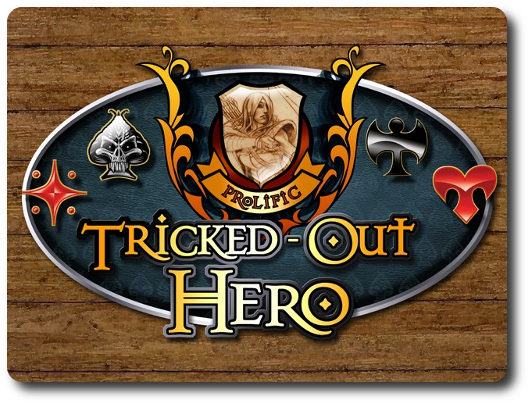
The Basics:
- For ages 6 and up (publisher suggests 12+)
- For 3 to 5 players
- Approximately 20 minutes per player
Geek Skills:
- Counting & Math
- Logical & Critical Decision Making
- Reading
- Memorization & Pattern/Color Matching
- Strategy & Tactics
- Risk vs. Reward
- Hand/Resource Management
Learning Curve:
- Child – Easy
- Adult – Easy
Theme & Narrative:
- Win tricks to survive
Endorsements:
- Gamer Geek approved!
- Parent Geek mixed!
- Child Geek approved!
Overview
Josh Billings said, “Life consists not in holding good cards but in playing those you hold well.” In this tick taking trump card game, your hero will live or perish based on how well you play your cards. Winning or loosing a trick could mean the difference between epic loot or a messy death. Fantasy meets trump in this card game that pits your wits against monsters and your opponents!
Tricked-Out Hero, designed by William Sininger and to be published by Prolific Games, will reportedly be comprised of 6 Character Sheets, 36 “Level 1” Monster cards, 36 “Level 2” Monster cards, 36 “Level 3” Monster cards, 54 customized Playing cards, 3 standard eight-sided dice, 4 Trump Determination cards, and 178 tokens that represent Melee, Magic, Health, and Monsters, among other things. As this is a review of a prepublished game, we will not comment on the game component quality. The proposed artwork, created by Ryan Johnson, is outstanding and further strengthens the game’s theme and narrative.
Game Set Up
To set up the game, first have the players select a Character Sheet. Each Character Sheet represents 1 hero the players will be using during the game. Heroes include, but are not limited to, the Monk, the Rogue, the Ranger, the Mage, the Fighter, and the Priest. Each hero has their own unique abilities and powers the players can use during the game. Any unused Character Sheets should be returned to the game box.
Second, give each player a number of tokens equal to the starting Health Points, Melee, and Magic as shown on their selected Character Sheet. Place the remaining tokens to one side.
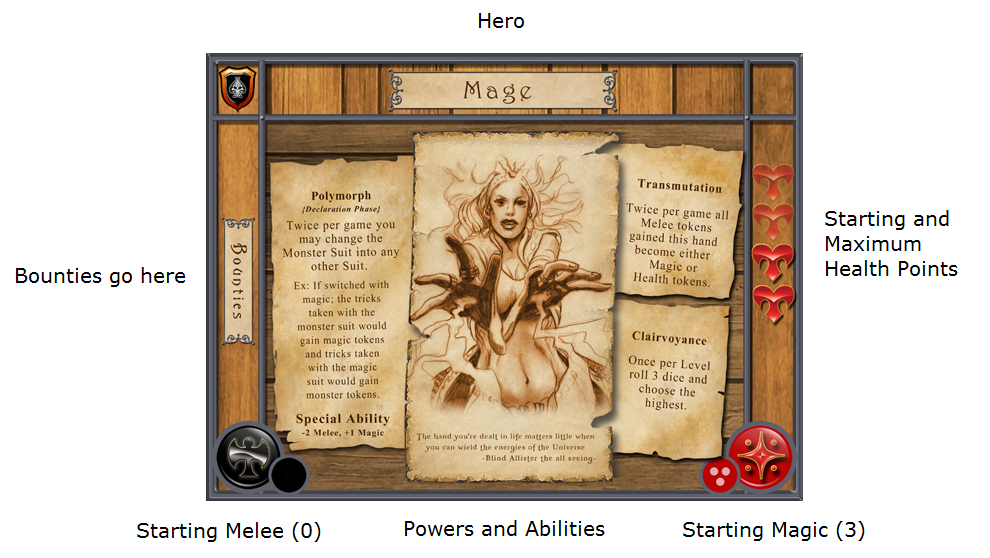
Third, take the Monster cards and separate them into their 3 different levels (levels 1, 2, and 3). These are the Monster Level decks. Shuffle each Monster Level deck separately and place them, face-down, next to the game playing area.
Fourth, shuffle the Trump Determination cards to create the Trump Determination deck. Place the Trump Determination deck, face-down, next to the Monster Level decks.
Fifth, take the Playing cards and remove the Jokers unless a Character Sheet states they are used. Shuffle the Playing cards and place the deck face-down.
That’s it for game set up. Determine who the first Dealer will be and let the adventuring begin!
Tricks, Traps, Trumps, and Treasures
Tricked-Out Hero is played in hands. Each hand will have several tricks. The following steps are taken during each hand.
Step 1: Deal
The Dealer gives each player 1 Monster card, face-down, from the appropriate Monster Level deck. The starting level for all players is Level 1. The Dealer then gives to each player a specific number of cards from the Playing card deck. The number of cards dealt is determined by the number of players in the game.
- 5-player game: 10 Playing cards to each player with the 2 remaining cards placed face-down to one side of the game playing area
- 4-player game: 13 Playing cards to each player
- 3-player game: 13 Playing cards to each player with the 13 remaining cards placed face-down to one side of the game playing area
Once the players have all their Playing cards, they should pick them up. This is the player’s hand. The player’s Monster card for the hand should remain face-down, but the players can look at them. Players should keep their hand hidden from their opponents at all times.
Step 2: Reveal the Trump Suit
The Dealer shuffles, draws, and reveals the top Trump Determination card from the Trump Determination deck. Place the Trump Determination card, face-up, on the Trump Determination deck. This determines the trump value for the hand.
Step 3: Power Declaration
Starting with the player to the Dealer’s left, each player will state if they are using a special power indicated on their Character Sheet. This is the only time the players will have an opportunity to use it for the hand, but the use of the power is limited. If the player states they will use their power, it’s resolved and the next player in turn order sequence goes. If the player passes, the next player in turn order sequence goes. Once all the players have either passed or used their hero’s power, the next step is taken.
Step 4: Play the Hand
The player to the Dealer’s left leads by playing 1 Playing card from their hand to the table, face-up. The first card played determines the suit to be played to. There are four suits. These are Health, Melee, Magic, and Monster. Going in turn order sequence, each player must play a card from their hand that matches the suit led if they have one. If they do not, they may play a card of any suit.
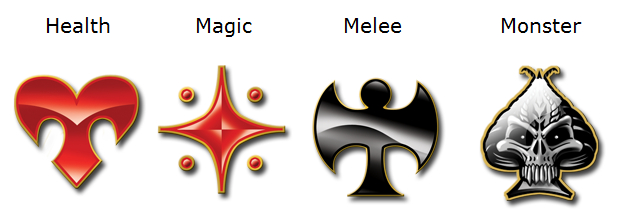
The highest card of the led suit or the highest card of the revealed trump suit wins the trick. The winner of the trick collects the cards and places them in a pile in front of them. The winner of the trick then leads the next trick. This continues until all the cards in the hand have been played.
After the last trick has been taken, players look through their collected Playing cards and take 1 matching token for each card they have won. For example, 1 “Health” token for every 1 Health suit card, 1 “Magic” token for every 1 Magic suit card, 1 “Melee” token for every 1 Melee suit card, and 1 “Monster” token for every Monster suit card. Note that the number of tokens collected and of what type is determine by the number of cards and their suit, not the number on the card.
If a player was unable to win any tricks, they have a “Nil Hand”. The player collects 3 tokens of any type (Melee, Magic, Health, or Monster). The player can take all 3 token from one type or mix and match.
Note that a hero can never have any more Health than their maximum, as defined on the Character Sheet. For every 2 Health tricks the player takes, the player can exchanged them for 1 Magic or 1 Melee token if they are maxed out.
Step 5: Combat
Each player now reveals their Monster card at the same time. Note that a player might have a hero with a special ability that allows them to change their Monster card before they reveal it. For example, the Rogue has a special ability called “Quick Foot Work” that allows the player to switch a Monster card with an opponent once per Monster Level, but must be done BEFORE any Monster cards are revealed!
Each Monster card will list a Melee, Magic, or generic target number. In order to defeat the monster, the player must roll a number higher than the listed target number. The player must determine if they will engage the monster in Melee or Magic combat if they are given a choice.
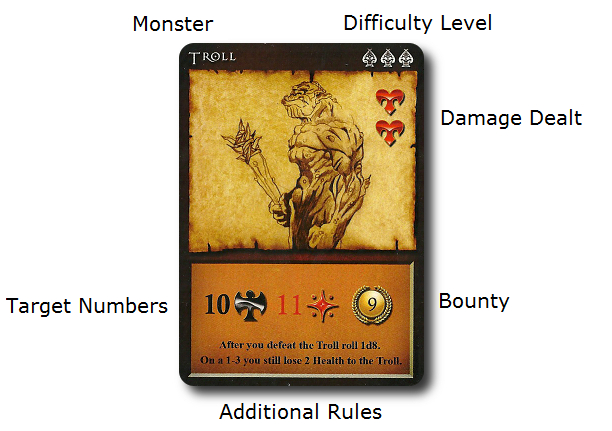
- For every token of the selected type (Magic or Melee) that player wants to spend, they will add a +1 to their rolled value
- For every Monster token collected during the hand, the monster’s target number is increased by +1
The player now takes an eight-sided die and rolls it. The total number of Magic or Melee tokens used is added to the rolled value. This is the player’s combat value. The player then compares their combat value to the monster’s combat value which is the target number plus the total number of Monster tokens.
- If the player’s combat value is equal to or higher than the monster’s target number, they have defeated the monster. Each monster lists a Bounty Point value. This value will be used to determine the winner of the game. The slain monster is placed by the player’s Character Sheet, face-up.
- If the player’s combat value is less than the monster’s target number, the hero’s Health Points are reduced by the monster’s listed damage. The monster goes free, but not before taking a chunk out of the hero.
Note that there are a few exceptions to the above rules when it comes to combat and monsters.
- Some monsters can only be engaged in certain types of combat
- Some monsters can be engaged with either Magic, Melee, or both
- Some monsters will have a defined rule that determines who they attack and when
- Chests have a target number that is not increased by Monster tokens, but the player cannot use Melee or Magic tokens to improve their rolled value
Once all combat has been resolved, the next step is taken.
Step 6: Clean Up and Advancement
When the hand is over, all the Playing cards are collected and reshuffled, the Monster cards played are collected by the player if the monster was defeated (otherwise, the monster is discarded), and players take a moment to quickly organize their collected tokens. Note that the only tokens a player is ever forced to play are the Monster tokens. Melee and Magic tokens can be “banked” by a player from one hand to the next and Health Points increase and decrease throughout the game.
The adventuring party will “level up” and fight the next highest monster level after every player has been the Dealer once per level. For example, after the last hand is completed and all the players have dealt, the “Level 1” Monster cards are set aside and the “Level 2” Monsters are now used. When the player’s level up, the also get a bonus.
- In a 3 to 4-player game, each player gains 1 token of either Magic, Melee, or Health between levels 1 and 2, and 2 tokens between levels 2 and 3.
- In a 5-player game, each player gains 2 tokens of either Magic, Melee, or Health between levels 1 and 2, and 3 tokens between levels 2 and 3.
These tokens are added to any tokens the player has not yet spent.
This completes the hand. The player to the Dealer’s left is now the new Dealer.
Death and Power
As long as a hero has at least 1 Health Point, they are considered healthy enough to delve into dungeons and fight bloody huge monsters. As soon as their Health Points are reduced to zero, they keel over and push up daisies. There is a fine line between life and death for a hero, but death is not the end. When a hero perishes, all their collected tokens are removed and they are resurrected. Resurrected players also get a Death token which reduces their die rolls by -1. A Death token can be removed if the player gets a “Nil Hand” or by advancing to the next level and sacrificing 1 token of any type to remove the Death token.
But as long as a hero is alive, they have the ability to do extraordinary things. Each hero has powers and abilities they can use to influence the game, their opponents, and outcomes. How the player uses them and when is up to them, but each hero’s power and abilities are limited. Some powers and abilities can only be used so many times per game or so many times per level. The power and abilities that each hero possesses is as unique as the hero themselves. This gives players different reasons to play certain cards…or not play them, subtly impacting game play without upsetting any game play balance as a result.
Some examples of powers and abilities include:
- Transmutation: Ability to change Melee tokens to Magic or Health tokens.
- Iron Skin: Roll a single eight-sided die after taking damage – on a roll of 7 or 8, damage is ignored.
- Sniper: Once per level, the hero engages the monster at a distance, avoiding damage as a result.
Winning the Game
The game ends when all the players have dealt whilst fighting “Level 3” monsters. When all the combat has been resolved, the players count their Bounty Points. The player who has collected the most wins the game. Ties are broken by counting the number of slain monsters the players have collected.
Game Variant
Instead of randomly dealing a Monster card to players during game set up, all the Monster cards are turned face-up and placed in the middle of the playing area for the specific level. The hand is played out as normal. The player with the least number of Bounty Points then chooses which monster they want to fight. Then the next lowest selects a monster and so on until all the players have selected a Monster card. If someone is playing with the Rogue, the “Quick Footwork” ability allows the player to pick a Monster card before any opponent, regardless of the player’s total Bounty Points.
To learn more about Tricked-Out Hero, visit the Kickstarter campaign.
Prediction
Tricked-Out Hero is essentially two different games. The first is a lot like the card game Hearts. Instead of the Spade suit (♠) being a point penalty card, the Monster suit is used. Which, if you look close, is a Spade. The second game is unique and builds off the simplicity of the first half to add depth and strategy. Throw in the Character Sheets with special hero powers and abilities, and you’ve got yourself a very unique card game with a common rule set that makes it easy to grasp.
In theory.
While I think the rules need some crisping up and a few grey areas need to be addressed, I don’t anticipate Tricked-Out Hero being a game that will be difficult to teach. It should do very well with the Child Geeks due to the fantasy theme, monsters to fight, and easy game play. The Child Geeks will mostly miss the importance of some serious hand management, but it will not be lost on the Parent and Gamer Geeks. The Parent Geeks should enjoy the game, but the fantasy aspect of the game might be perceived as a bit overpowering to those non-gamer Parent Geeks. At the very least, the Parent Geeks will give the game a mixed approval rating. The Gamer Geeks should very much enjoy Tricked-Out Hero as a light card game that requires some serious hand management to be competitive.
After teaching the card game to both my 9-year-old and my 6-year-old, I asked them their thoughts on Tricked-Out Hero so far.
“Really cool concept. We already know how to play the first part of the game, and I LOVE how you get to fight monsters.” ~ Liam (age 9)
“We’ve already played part of this game, but not the monster fighting part. I think it looks like a fun game.” ~ Nyhus (age 6)
Both of my two oldest little geeks know how to play Hearts and are familiar with trump games. I have no doubt they’ll be able the play the first part of the game without issue. How well they fare in the dungeons will be up to them.
Final Word
The Child Geeks enjoyed the game, but their level of excitement dropped a bit when they weren’t able to get the tricks they wanted. For example, one Child Geek kept winning the tricks with an unfortunate hand that included high numbered Monster suit cards. No fun for him, but all the Child Geeks loved the monsters and the combat. I’m pretty sure a few of them rushed the hands to get to the fighting. That would be pretty funny if they did, as they clearly missed the point and the importance of the hand to begin with. But the hand and trick playing seems pretty unimportant and unimpressive when fighting a Skeleton Warrior! All the Child Geeks voted to approve Tricked-Out Hero, with various degrees of energetic enthusiasm for the game.
Note that a player does not need to be able to read to play this game, but they must be able to do simple math. What little reading that is needed can be done by another player without impacting the game play.
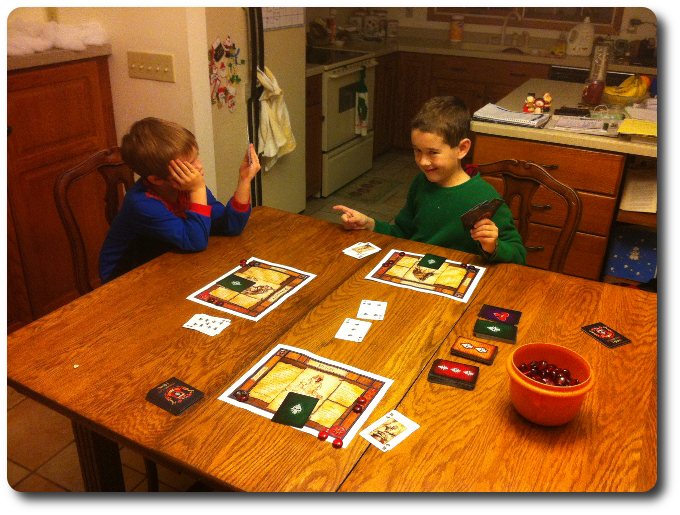
My 6-year-old frowns as he realizes he has to take a trick that will give him Monster tokens
The Parent Geeks were oddly mixed when it game to Tricked-Out Hero. The Parent Geeks who enjoyed thematic games liked Tricked-Out Hero a great deal. According to one Parent Geek, “This makes card games fun again! BRING ON THE DRAGON!” The Parent Geeks who did not, mainly the non-gamers, were put out by the thematic elements of the game, including the combat. According to one of these Parent Geeks, “I don’t know why you need to add monsters and magic to a card game that works well enough as it is.” None of the Parent Geeks thought the hand playing was bad, but the Parent Geeks were split on the value the monster fighting, hero leveling, and dungeon delving provided. The Parent Geeks agreed to disagree. For those who enjoyed it, they loved playing it with their family and their peers. For those who didn’t, they asked for just a standard deck of cards and a bowl of popcorn to munch on while they played.
The Gamer Geeks enjoyed the game, but found the flow of the game to be a bit disjointed at times. According to one Gamer Geek, “This game starts out solid, plays fast, and then suddenly comes to a crashing stop as each player has to handle combat. The downtime isn’t long but it feels out-of-place after the fast card plays.” All the Gamer Geeks agree, but the sudden drop in speed didn’t persuade them to stop playing the game. According to one Gamer Geek, “I found the game play to be strangely addicting. I would love to play this with my family and friends.” When the game was put away and the Gamer Geeks were given a moment to think about their experience with Tricked-Out Hero, they all agreed the game was “surprisingly good” and provided a “unique game playing experience”. One Gamer Geek wanted the last word and said, “This game is not the best and is far from the worst. I liked it, would play it again, and that’s all I have to say about it.”
I very much enjoyed my time with Tricked-Out Hero. While I am unable to give the game the Father Geek Seal of Approval due to the Parent Geeks giving it a mixed approval rating, it most certainly pleased me. The only aspect of the game that felt a bit clunky at times was the individual player battles with their Monster card. It can feel a bit jolting at first switching from intense player interaction to a solitaire number crunching exercise with a dice roll. But it works and works well, despite the sudden shift in focus and energy. I wanted the hero and fantasy aspect of the game to be a bit more involved, too. The heroes and fantasy adventure is there, but it feels a bit pasted on most of the time. Didn’t hurt the game play, but I never felt like I was a hero exploring a dungeon.
Tricked-Out Hero provides a neat new way to play cards. It combines easy rules with smart game play, resulting in a fun experience that will leave you with a positive impression.
This game was given to Father Geek as a review copy. Father Geek was not paid, bribed, wined, dined, or threatened in vain hopes of influencing this review. Such is the statuesque and legendary integrity of Father Geek.




Sounds Great I have a an addition that might work as a more intense dungeon element why not add a small fold out board with ten or twelve rooms on it with a of course a tavern that everybody starts in and as you play your tricks for as many tricks that are taken why not move throughout the rooms with leveled monsters inside the the rooms for combat along with your hidden monster card as a wandering monster you would have the best of both worlds a trick taking card game and a dungeon and siege game with treasures available as well.
Pingback: Today in Board Games Issue #100 - Today in Board Games